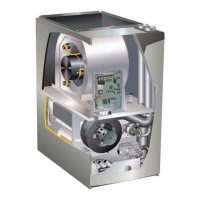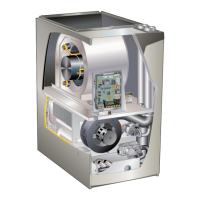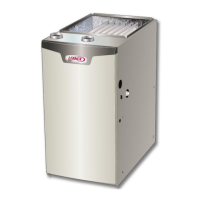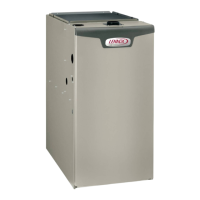Page 60
Heating Sequence of Operation
Electronic Ignition
The two-stage, variable speed integrated control used
in EL296DFV units has an added feature of an internal
Watchguardcontrol. The feature serves as an automatic
reset devicefor ignition control lockout caused by ignition
failure. Afterone hour of continuous thermostat demand
for heat, theWatchguard will break and remake thermostat
demand tothe furnace and automatically reset the control
to begin theignition sequence.
NOTE - The ignition control thermostat selection DIP
switch is factory-set in the “TWO-STAGE” position.
Applications Using a Two-Stage Thermostat See FIG-
URE 62 for ignition control sequence
A - Heating Sequence -- Integrated Control Thermo-
stat Selection DIP Switch 1 OFF in “Two-Stage” Posi-
tion (Factory Setting)
1 - On a call for heat, thermostat rst-stage contacts
close sending a signal to the integrated control. The
integrated control runs a self-diagnostic program
and checks high temperature limit switches for
normally closed contacts and pressure switches for
normally open contacts. The combustion air inducer
is energized at low speed.
2 - Once the control receives a signal that the low
pressure switch has closed, the combustion air
inducer begins a 15-second pre-purge in low speed.
NOTE - If the low re pressure switch does not close
the combustion air inducer will switch to high re.
After a 15 second pre-purge the high re pressure
switch will close and the unit will begin operation on
high re. After 10 to 20 seconds of high re operation
the unit will switch to low re..
3 - After the pre-purge is complete, a 20-second initial
ignitor warm-up period begins. The combustion air
inducer continues to operate at low speed.
4 - After the 20-second warm-up period has ended, the
gas valve is energized on low re (rst stage) and
ignition occurs. At the same time, the control module
sends a signal to begin an indoor blower 30-second
ON-delay. When the delay ends, the indoor blower
motor is energized on the low re heating speed, the
HUM contacts close energizing the humidier and
120V ACC terminal is energized. The furnace will
continue this operation as long as the thermostat has
a rst-stage heating demand.
5 - If second-stage heat is required, the thermostat
second- stage heat contacts close and send a signal
to the integrated control. The integrated control
initiates a 30-second second-stage recognition
delay.
6 - At the end of the recognition delay, the integrated
control energizes the combustion air inducer at high
speed. The control also checks the high re (second
stage) pressure switch to make sure it is closed. The
high re (second stage) gas valve is energized and
the indoor blower motor is energized for operation at
the high re heating speed.
7 - When the demand for high re (second stage) heat
is satised, the combustion air inducer is switched to
the low-re heating speed and the high-re (second
stage) gas valve is de-energized. The low-re (rst
stage) gas valve continues operation. The indoor
blower motor is switched to the low-re heating
speed.
8 - When the thermostat demand for low-re (rst stage)
heat is satised, the gas valve is de-energized and
the eld-selected indoor blower o delay begins.
The combustion air inducer begins a 5-second post-
purge period.
9 - When the combustion air post-purge period is
complete, the inducer and the HUM contacts are
de-energized. The indoor blower is de-energized at
the end of the o delay as well as the 120V ACC
terminals.
Applications Using A Single-Stage Thermostat See
FIGURE 63 for ignition control sequence
B - Heating Sequence -- Integrated Control Thermostat
Selection DIP Switch 1 ON in “Single-Stage” Position
NOTE - In these applications, two-stage heat will be initi-
ated by the integrated control if heating demand has not
been satised after the eld adjustable period (7 or 12
minutes).
1 - On a call for heat, thermostat rst-stage contacts
close sending a signal to the integrated control. The
integrated control runs a self-diagnostic program
and checks high temperature limit switches for
normally closed contacts and pressure switches for
normally open contacts. The combustion air inducer
is energized at low speed.
2 - Once the control receives a signal that the low
pressure switch has closed, the combustion air
inducer begins a 15-second pre-purge in low speed.
NOTE - If the low re pressure switch does not close
the combustion air inducer will switch to high re.
After a 15 second pre-purge the high re pressure
switch will close and the unit will begin operation on
high re. After 10 to 20 seconds of high re operation
the unit will switch to low re.
3 - After the pre-purge is complete, a 20-second initial
ignitor warm-up period begins. The combustion air
inducer continues to operate at low speed.
4 - After the 20-second warm-up period has ended, the
gas valve is energized on low re (rst stage) and
ignition occurs. At the same time, the control module
sends a signal to begin an indoor blower 30-second
ON-delay. When the delay ends, the indoor blower
motor is energized on the low re heating speed,
the HUM contacts close energizing the humidier
and 120V ACC terminal is energized. The integrated
control also initiates a second-stage on delay
(factory-set at 7 minutes; adjustable to 12 minutes).
5 - If the heating demand continues beyond the
secondstage on delay, the integrated control
energizes the combustion air inducer at high speed.
The control also checks the high re (second stage)
pressure switch to make sure it is closed. The high
re (second stage) gas valve is energized and the
indoor blower motor is energized for operation at the
high re heating speed.

